Abstract
Cryptococcus infections of the lung and central nervous system have become major problems in immuno-compromised patients, leading to the need for additional treatment protocols. We have utilized a Cryptococcus-mouse model that mimics human cryptococcal disease to evaluate the efficacy of amphotericin B-liposomes (AmpB-Lip) when delivered by small-particle aerosol (SPA). In the model, initial intranasal inoculation leads to a pulmonary infection that spreads after 2 to 3 weeks to distant organs, including the brain. Aerosols of AmpB-Lip that were generated by a Collison nebulizer had mass median aerodynamic diameters of 1.8 microns and contained 10.3 micrograms of AmpB per liter. When AmpB-Lip SPA was begun at 24 h postinoculation, a single 2-h treatment (0.3 mg of AmpB per kg of body weight) was effective in reducing pulmonary Cryptococcus infection. This regimen was more effective than intravenous administration of AmpB-Lip given for 3 continuous days. This single 2-h exposure to AmpB-Lip also was effective in reducing pulmonary Cryptococcus infection when treatment was delayed for 7 or 14 days. At day 21, when organisms had spread to the brain in all animals, the single 2-h aerosol treatment reduced the number of cryptococci in the brain as well as in the lungs. AmpB-Lip SPA administered once for 2 h on days 7, 14, and 21 also was effective in increasing the duration of survival of infected animals. These results demonstrate that aerosolized AmpB-Lip can be effective in treating both local, pulmonary Cryptococcus disease and systemic disease.
Full text
PDF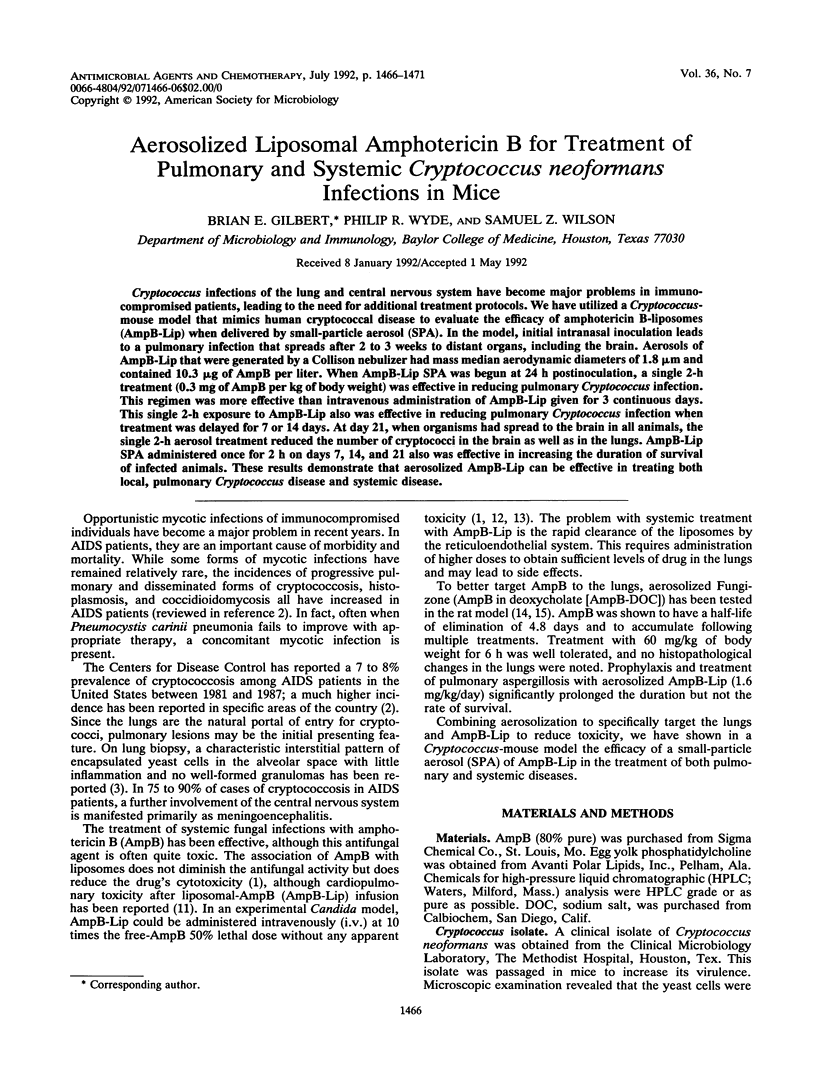
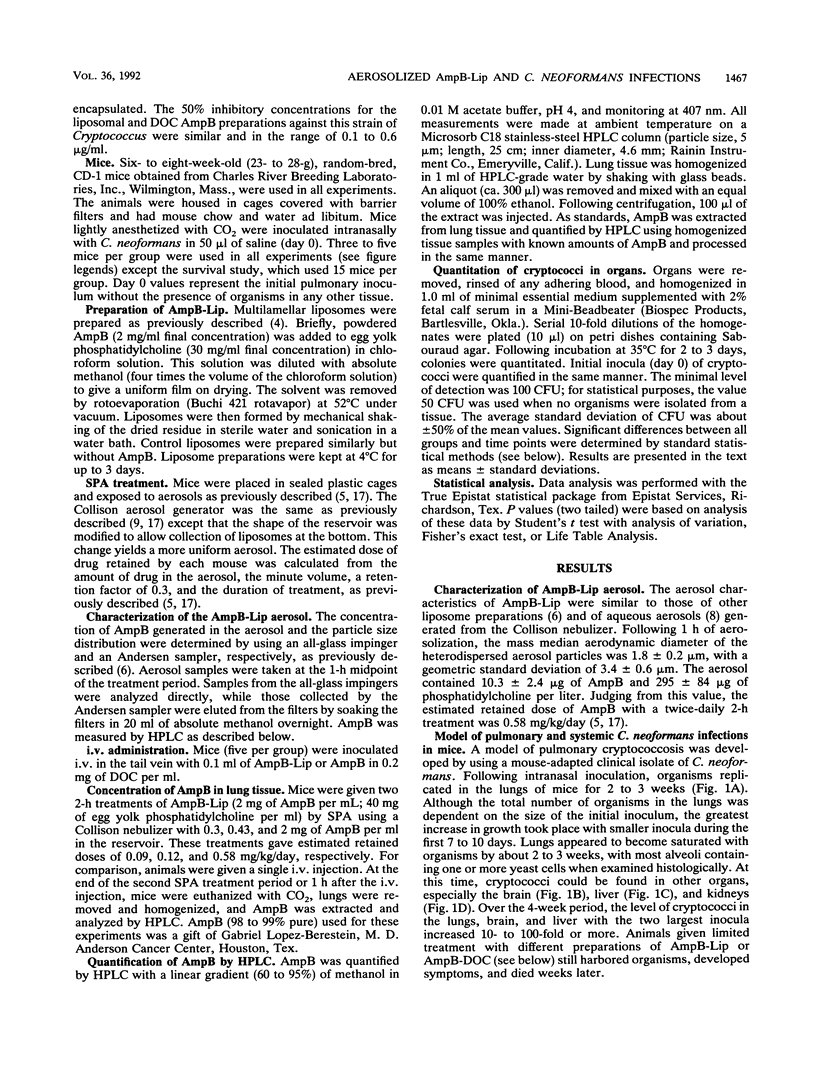
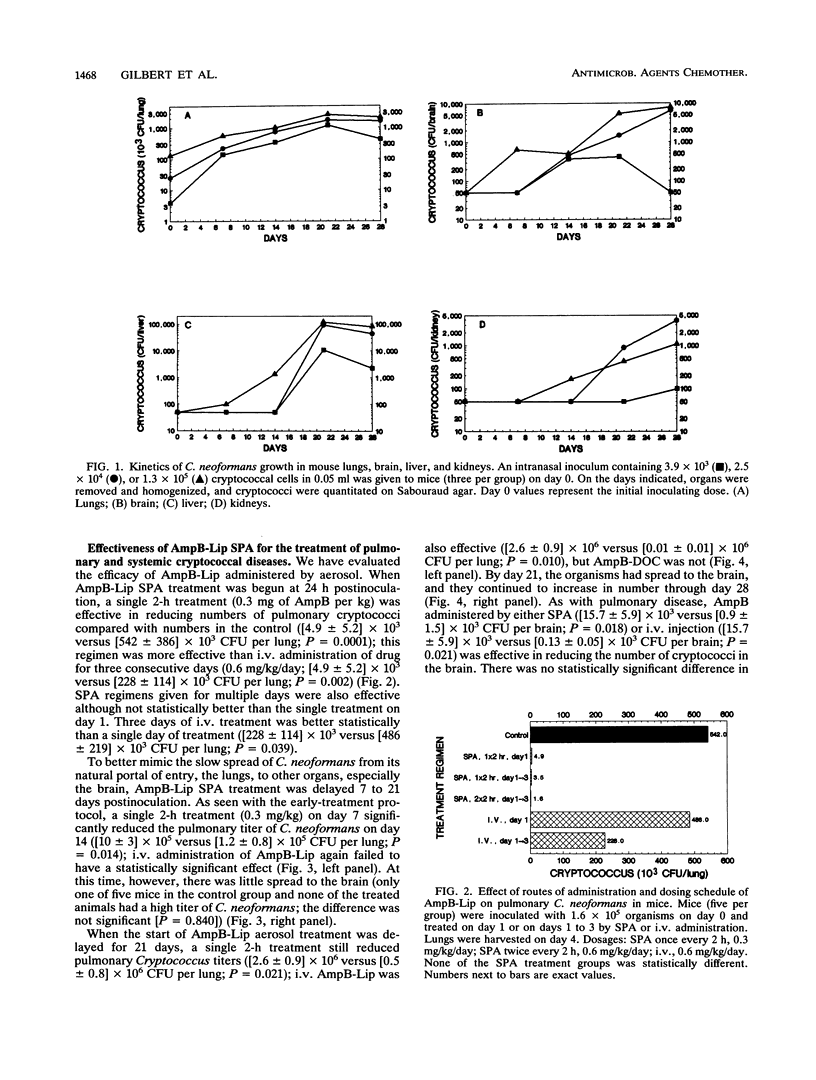
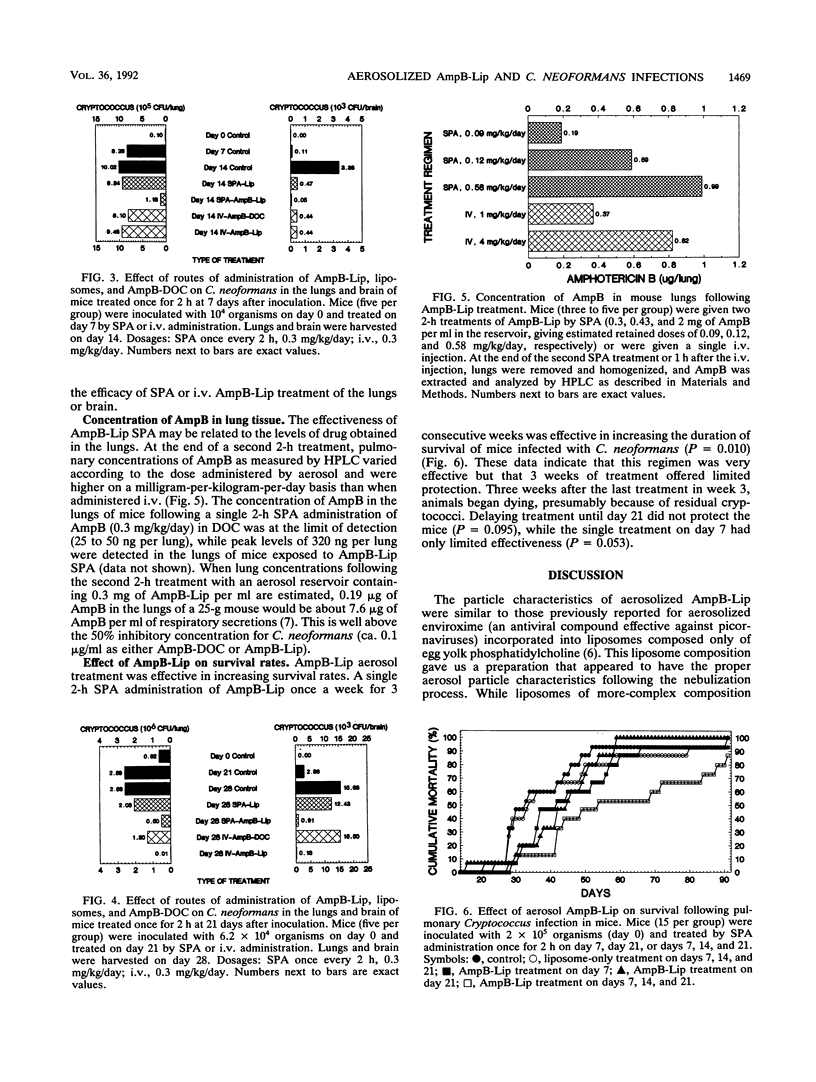
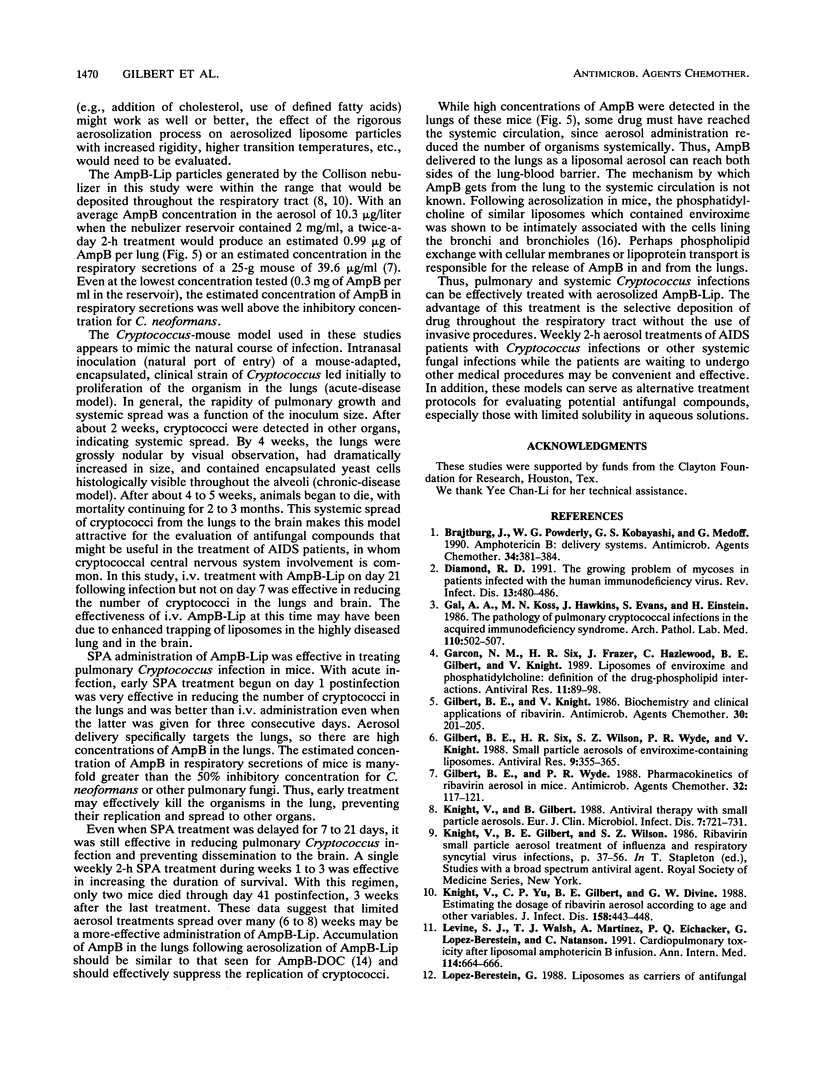
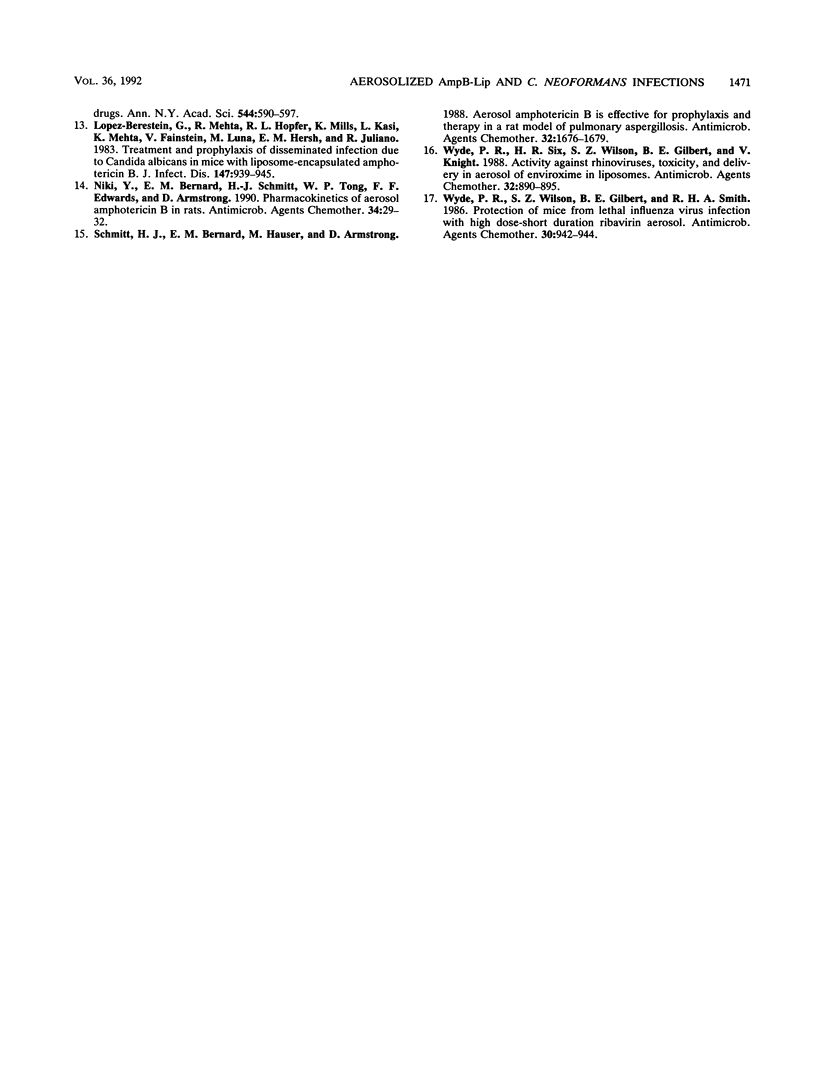
Selected References
These references are in PubMed. This may not be the complete list of references from this article.
- Brajtburg J., Powderly W. G., Kobayashi G. S., Medoff G. Amphotericin B: delivery systems. Antimicrob Agents Chemother. 1990 Mar;34(3):381–384. doi: 10.1128/aac.34.3.381. [DOI] [PMC free article] [PubMed] [Google Scholar]
- Diamond R. D. The growing problem of mycoses in patients infected with the human immunodeficiency virus. Rev Infect Dis. 1991 May-Jun;13(3):480–486. doi: 10.1093/clinids/13.3.480. [DOI] [PubMed] [Google Scholar]
- Gal A. A., Koss M. N., Hawkins J., Evans S., Einstein H. The pathology of pulmonary cryptococcal infections in the acquired immunodeficiency syndrome. Arch Pathol Lab Med. 1986 Jun;110(6):502–507. [PubMed] [Google Scholar]
- Garcon N. M., Six H. R., Frazer J., Hazlewood C., Gilbert B. E., Knight V. Liposomes of enviroxime and phosphatidylcholine: definition of the drug-phospholipid interactions. Antiviral Res. 1989 Mar;11(2):89–98. doi: 10.1016/0166-3542(89)90011-9. [DOI] [PubMed] [Google Scholar]
- Gilbert B. E., Knight V. Biochemistry and clinical applications of ribavirin. Antimicrob Agents Chemother. 1986 Aug;30(2):201–205. doi: 10.1128/aac.30.2.201. [DOI] [PMC free article] [PubMed] [Google Scholar]
- Gilbert B. E., Six H. R., Wilson S. Z., Wyde P. R., Knight V. Small particle aerosols of enviroxime-containing liposomes. Antiviral Res. 1988 Sep;9(6):355–365. doi: 10.1016/0166-3542(88)90037-x. [DOI] [PubMed] [Google Scholar]
- Gilbert B. E., Wyde P. R. Pharmacokinetics of ribavirin aerosol in mice. Antimicrob Agents Chemother. 1988 Jan;32(1):117–121. doi: 10.1128/aac.32.1.117. [DOI] [PMC free article] [PubMed] [Google Scholar]
- Knight V., Gilbert B. Antiviral therapy with small particle aerosols. Eur J Clin Microbiol Infect Dis. 1988 Dec;7(6):721–731. doi: 10.1007/BF01975037. [DOI] [PubMed] [Google Scholar]
- Knight V., Yu C. P., Gilbert B. E., Divine G. W. Estimating the dosage of ribavirin aerosol according to age and other variables. J Infect Dis. 1988 Aug;158(2):443–448. doi: 10.1093/infdis/158.2.443. [DOI] [PubMed] [Google Scholar]
- Levine S. J., Walsh T. J., Martinez A., Eichacker P. Q., Lopez-Berestein G., Natanson C. Cardiopulmonary toxicity after liposomal amphotericin B infusion. Ann Intern Med. 1991 Apr 15;114(8):664–666. doi: 10.7326/0003-4819-114-8-664. [DOI] [PubMed] [Google Scholar]
- Lopez-Berestein G. Liposomes as carriers of antifungal drugs. Ann N Y Acad Sci. 1988;544:590–597. doi: 10.1111/j.1749-6632.1988.tb40459.x. [DOI] [PubMed] [Google Scholar]
- Lopez-Berestein G., Mehta R., Hopfer R. L., Mills K., Kasi L., Mehta K., Fainstein V., Luna M., Hersh E. M., Juliano R. Treatment and prophylaxis of disseminated infection due to Candida albicans in mice with liposome-encapsulated amphotericin B. J Infect Dis. 1983 May;147(5):939–945. doi: 10.1093/infdis/147.5.939. [DOI] [PubMed] [Google Scholar]
- Niki Y., Bernard E. M., Schmitt H. J., Tong W. P., Edwards F. F., Armstrong D. Pharmacokinetics of aerosol amphotericin B in rats. Antimicrob Agents Chemother. 1990 Jan;34(1):29–32. doi: 10.1128/aac.34.1.29. [DOI] [PMC free article] [PubMed] [Google Scholar]
- Schmitt H. J., Bernard E. M., Häuser M., Armstrong D. Aerosol amphotericin B is effective for prophylaxis and therapy in a rat model of pulmonary aspergillosis. Antimicrob Agents Chemother. 1988 Nov;32(11):1676–1679. doi: 10.1128/aac.32.11.1676. [DOI] [PMC free article] [PubMed] [Google Scholar]
- Wyde P. R., Six H. R., Wilson S. Z., Gilbert B. E., Knight V. Activity against rhinoviruses, toxicity, and delivery in aerosol of enviroxime in liposomes. Antimicrob Agents Chemother. 1988 Jun;32(6):890–895. doi: 10.1128/aac.32.6.890. [DOI] [PMC free article] [PubMed] [Google Scholar]
- Wyde P. R., Wilson S. Z., Gilbert B. E., Smith R. H. Protection of mice from lethal influenza virus infection with high dose-short duration ribavirin aerosol. Antimicrob Agents Chemother. 1986 Dec;30(6):942–944. doi: 10.1128/aac.30.6.942. [DOI] [PMC free article] [PubMed] [Google Scholar]


